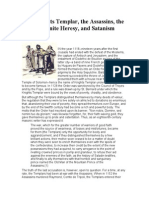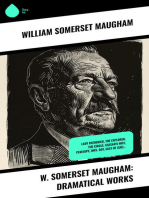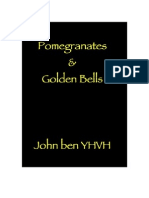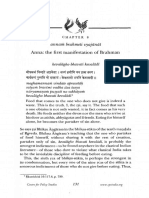Damascus Document: Brit Damesek
Damascus Document: Brit Damesek
Uploaded by
cassannovaCopyright:
Available Formats
Damascus Document: Brit Damesek
Damascus Document: Brit Damesek
Uploaded by
cassannovaOriginal Description:
Original Title
Copyright
Available Formats
Share this document
Did you find this document useful?
Is this content inappropriate?
Copyright:
Available Formats
Damascus Document: Brit Damesek
Damascus Document: Brit Damesek
Uploaded by
cassannovaCopyright:
Available Formats
Damascus Document
Brit Damesek
4Q271(Df)
Parchment
Copied late first century B.C.E.
Height 10.9 cm (4 1/4 in.), length 9.3 cm (3 5/8 in.)
Courtesy of the Israel Antiquities Authority (1)
The Damascus Document is a collection of rules and instructions reflecting the practices
of a sectarian community. It includes two elements. The first is an admonition that
implores the congregation to remain faithful to the covenant of those who retreated from
Judea to the "Land of Damascus." The second lists statutes dealing with vows and oaths,
the tribunal, witnesses and judges, purification of water, Sabbath laws, and ritual
cleanliness. The right-hand margin is incomplete. The left-hand margin was sewn to
another piece of parchment, as evidenced by the remaining stitches.
In 1896, noted Talmud scholar and educator Solomon Schechter discovered sectarian
compositions which later were found to be medieval versions of the Damascus
Document. Schechter's find in a synagogue storeroom near Cairo, almost fifty years
before the Qumran discoveries, may be regarded as the true starting point of modern
scroll research.
References
Baumgarten, J. "The Laws of the Damascus Document in Current Research." In
The Damascus Document Reconsidered. Edited by M. Broshi. Jerusalem, 1992.
Written by Baltimore Hebrew University scholar Joseph Baumgarten, this 1992
imprint includes an analysis of the Damascus Document and its relation to Jewish
Law, or halakhah.
Rabin, C. The Zadokite Documents. Oxford, 1958.
Schechter, S. Fragments of a Zadokite Work: Documents of Jewish Sectaries, vol.
1. Cambridge, England, 1910.
English Translation of Damascus Document (Brit
Damesek)
4Q271(Df)
Courtesy of the Israel Antiquities Authority (1)
1. ...with money...
2. ...[his means did not] suffice to [return it to him] and the year [for redemption
approaches?]...
3. ...and may God release him? from his sins. Let not [ ] in one, for
4. it is an abomination....And concerning what he said (Lev. 25:14), ["When you sell
5. anything to or buy anything from] your neighbor, you shall not defraud one
another," this is the expli[cation...
6. ...] everything that he knows that is found...
7. ...and he knows that he is wronging him, whether it concerns man or beast. And if
8. [a man gives his daughter to another ma]n, let him disclose all her blemishes to
him, lest he bring upon himself the judgement
9. [of the curse which is said (Deut. 27:18)] (of the one) that "makes the blind to
wander out of the way." Moreover, he should not give her to one unfit for her, for
10. [that is Kila'yim, (plowing with) o]x and ass and wearing wool and linen together.
Let no man bring
11. [a woman into the holy] who has had sexual experience, whether she had such
experience
12. [in the home] of her father or as a widow who had intercourse after she was
widowed. And any woman
13. [upon whom] there is a bad name in her maidenhood in her father's home, let no
man take her, except
14. [upon examination] by reliable [women] who have clear knowledge, by command
of the Supervisor over
15. [the Many. After]ward he may take her, and when he takes her he shall act in
accordance with the law ...and he shall not tell...
16. [ ] L [ ]
Transcription and translation by J. Baumgarten
You might also like
- So Called Contradictions in BibleDocument43 pagesSo Called Contradictions in Biblerichlion100% (5)
- Michael Kelly - The Sevenfold MysteryDocument838 pagesMichael Kelly - The Sevenfold MysterySage Sound88% (16)
- The Gift - AnalysisDocument1 pageThe Gift - AnalysisAnonymous btn1SCNo ratings yet
- Old Charges (Prestonian Lecture) McLeod 1986Document18 pagesOld Charges (Prestonian Lecture) McLeod 1986Nick Samuel CaveNo ratings yet
- Hamlets MillDocument1 pageHamlets Millcassannova0% (8)
- Indonesian ArchitectureDocument25 pagesIndonesian ArchitectureKhalid Ali Saif Al-ShamsiNo ratings yet
- Goddesses and Gods of The Ancient EgyptiansDocument211 pagesGoddesses and Gods of The Ancient Egyptiansdeus_primusNo ratings yet
- The Core Ethical Teachings: EthicsDocument3 pagesThe Core Ethical Teachings: EthicsRich Arandia100% (1)
- The Distinctions Made Among The Priests of The Devil Were As FollowsDocument3 pagesThe Distinctions Made Among The Priests of The Devil Were As FollowsMariel Abatayo80% (10)
- Sefer HaYashar (Midrash)Document135 pagesSefer HaYashar (Midrash)leventku2000No ratings yet
- THE LETTER OF ARISTEAS - A Book of the ApocryphaFrom EverandTHE LETTER OF ARISTEAS - A Book of the ApocryphaRating: 5 out of 5 stars5/5 (1)
- Historica ("Historical Library"), Consisted of Forty Books. The First Book Describe TheDocument14 pagesHistorica ("Historical Library"), Consisted of Forty Books. The First Book Describe TheAntwain UtleyNo ratings yet
- Observations Upon The PropheDocument194 pagesObservations Upon The ProphepwatlerNo ratings yet
- The Oldest Code of Laws in the World: The code of laws promulgated by Hammurabi, King of Babylon, B.C. 2285-2242From EverandThe Oldest Code of Laws in the World: The code of laws promulgated by Hammurabi, King of Babylon, B.C. 2285-2242No ratings yet
- םיםט טִ פ פְט ששש ה ששששרשפ Parashah Shofetim "Judges": BreakdownDocument10 pagesםיםט טִ פ פְט ששש ה ששששרשפ Parashah Shofetim "Judges": BreakdownMalachi3_6No ratings yet
- The Witchcraft Delusion in Colonial Connecticut: Historical Account of Witch Trials in Early Modern Period: 1647-1697From EverandThe Witchcraft Delusion in Colonial Connecticut: Historical Account of Witch Trials in Early Modern Period: 1647-1697No ratings yet
- The Jewish StateDocument2 pagesThe Jewish StateAntiVote.NetNo ratings yet
- The Noahide LawsDocument20 pagesThe Noahide LawsIlyes FerenczNo ratings yet
- Aleister Crowley - Liber 008 The Ritual Proper For The Invocation of Augoeides Cd4 Id1766060771 Size275Document5 pagesAleister Crowley - Liber 008 The Ritual Proper For The Invocation of Augoeides Cd4 Id1766060771 Size275SvejakNo ratings yet
- Ahiman Rezon - Laurence Dermott (1764) PDFDocument273 pagesAhiman Rezon - Laurence Dermott (1764) PDFPablo Guedes100% (1)
- Met Anthony Kiss of JudasDocument14 pagesMet Anthony Kiss of JudasMaxNo ratings yet
- The Chronology of The Babylonian CaptivityDocument20 pagesThe Chronology of The Babylonian CaptivityTheodore James Turner100% (1)
- The Bible, Douay-Rheims, Book 45: 1 Machabees The Challoner RevisionFrom EverandThe Bible, Douay-Rheims, Book 45: 1 Machabees The Challoner RevisionNo ratings yet
- Observations upon the Prophecies of Daniel, and the Apocalypse of St. JohnFrom EverandObservations upon the Prophecies of Daniel, and the Apocalypse of St. JohnNo ratings yet
- Prophetic Expositions Vol. 2Document124 pagesProphetic Expositions Vol. 2auvnegociosmultiplesNo ratings yet
- The Protocols of Zion - Further Proofs of Its AuthenticityDocument8 pagesThe Protocols of Zion - Further Proofs of Its Authenticityadam ho100% (1)
- Observations Upon The Prophecies of Daniel, and The Apocalypse of St. John by Newton, Isaac, 1642-1727Document103 pagesObservations Upon The Prophecies of Daniel, and The Apocalypse of St. John by Newton, Isaac, 1642-1727Gutenberg.orgNo ratings yet
- Look Up Your Redemption Draweth NighDocument3 pagesLook Up Your Redemption Draweth NighErrol Smythe0% (1)
- Socratic Seminar - Medieval EuropeDocument4 pagesSocratic Seminar - Medieval Europeyz2f222kkbNo ratings yet
- The Witchcraft Delusion in New England (The Complete Three-Volume Edition)From EverandThe Witchcraft Delusion in New England (The Complete Three-Volume Edition)No ratings yet
- Observations Upon The Prophecies of Daniel, and The Apocalypse ofDocument192 pagesObservations Upon The Prophecies of Daniel, and The Apocalypse ofBen100% (6)
- Antimatrix Org Convert Books 100 Laws of Shulchan Aruch DR Eckert Zertzalo en HTDocument195 pagesAntimatrix Org Convert Books 100 Laws of Shulchan Aruch DR Eckert Zertzalo en HTstrahinjaoNo ratings yet
- The Silver Trumpet, Vol. 1, Nos. 15-16Document64 pagesThe Silver Trumpet, Vol. 1, Nos. 15-16Trent Riffin WildeNo ratings yet
- Apocalypse of ElijahDocument15 pagesApocalypse of ElijahgiiovcastroNo ratings yet
- Observations Upon The Prophecies of Daniel, and The Apocalypse of St. John, by Isaac NewtonDocument138 pagesObservations Upon The Prophecies of Daniel, and The Apocalypse of St. John, by Isaac NewtonGabriel Mourente0% (1)
- The Covenanters of Damascus; A Hitherto Unknown Jewish SectFrom EverandThe Covenanters of Damascus; A Hitherto Unknown Jewish SectNo ratings yet
- 2520 Prophecy PDFDocument33 pages2520 Prophecy PDFNemani DianimotoNo ratings yet
- Even If They CanDocument6 pagesEven If They CanVincent JamanetNo ratings yet
- Nesta Webster - The Knights TemplarDocument22 pagesNesta Webster - The Knights TemplarFrog_bogNo ratings yet
- The Annals of The English BibleDocument22 pagesThe Annals of The English BibleChipego MungailaNo ratings yet
- The Discovery of WitchesDocument80 pagesThe Discovery of WitchesStelioPassarisNo ratings yet
- The Apocalypse of Thomas: Christian Apocrypha and Early Christian LiteratureDocument14 pagesThe Apocalypse of Thomas: Christian Apocrypha and Early Christian LiteratureAdim AresNo ratings yet
- Hengstenberg - Christology of The OT Vol IIIDocument468 pagesHengstenberg - Christology of The OT Vol IIIMihalache CosminaNo ratings yet
- Instant ebooks textbook Newton Papers The Strange and True Odyssey of Isaac Newton s Manuscripts 1st Edition Sarah Dry download all chaptersDocument77 pagesInstant ebooks textbook Newton Papers The Strange and True Odyssey of Isaac Newton s Manuscripts 1st Edition Sarah Dry download all chapterspiroksudikcx100% (1)
- The David Koresh ManuscriptDocument22 pagesThe David Koresh Manuscriptthe freelance mystic100% (1)
- The Book of The Law 2Document42 pagesThe Book of The Law 2hdzlizeth.0305No ratings yet
- Complete Download Introduction to Building 4th Edition Mitchell s Building Series Derek Osbourn PDF All ChaptersDocument36 pagesComplete Download Introduction to Building 4th Edition Mitchell s Building Series Derek Osbourn PDF All ChapterswillienegiiNo ratings yet
- Irish Wit and Humor Anecdote Biography of Swift, Curran, O'Leary and O'ConnellFrom EverandIrish Wit and Humor Anecdote Biography of Swift, Curran, O'Leary and O'ConnellNo ratings yet
- Extraordinary Trials of the 20th Century: The British Crown Versus the Last of the WitchesFrom EverandExtraordinary Trials of the 20th Century: The British Crown Versus the Last of the WitchesNo ratings yet
- The Fourth Grand MasterDocument6 pagesThe Fourth Grand MasterSANDY CAROLINA MONTAÑANo ratings yet
- Focus On 3D Terrain Programming (Game Development) all chapter instant downloadDocument24 pagesFocus On 3D Terrain Programming (Game Development) all chapter instant downloadharlivecih100% (3)
- W. Somerset Maugham: Dramatical Works: Lady Frederick, The Explorer, The Circle, Caesar's Wife, Penelope, Mrs. Dot, East of Suez…From EverandW. Somerset Maugham: Dramatical Works: Lady Frederick, The Explorer, The Circle, Caesar's Wife, Penelope, Mrs. Dot, East of Suez…No ratings yet
- CosmosDocument2 pagesCosmoscassannovaNo ratings yet
- Gauss PHD DissertationDocument28 pagesGauss PHD DissertationcassannovaNo ratings yet
- Human Soul and Science 201009Document9 pagesHuman Soul and Science 201009cassannovaNo ratings yet
- Abdus Salam Problem of RamanujanDocument2 pagesAbdus Salam Problem of RamanujancassannovaNo ratings yet
- The Lost Jesus ScrollDocument94 pagesThe Lost Jesus Scrollcassannova100% (8)
- Desatir On The Eye of The HeartDocument4 pagesDesatir On The Eye of The HeartcassannovaNo ratings yet
- The Gathas of ZoroasterDocument55 pagesThe Gathas of ZoroasterAnth0ny999100% (1)
- I Am The Way and The Truth and The LifeDocument2 pagesI Am The Way and The Truth and The LifecassannovaNo ratings yet
- The Sufi Path of Love - The Spiritual Teachings of Rumi (By W. C. Chittick)Document912 pagesThe Sufi Path of Love - The Spiritual Teachings of Rumi (By W. C. Chittick)Mohammed Salih100% (11)
- The First English Translation of RiemannDocument11 pagesThe First English Translation of RiemanncassannovaNo ratings yet
- Essence 1Document543 pagesEssence 12Moha2No ratings yet
- Treasure House of PrayersDocument237 pagesTreasure House of PrayersSher Jung ZiddiNo ratings yet
- Jesus in India PDFDocument164 pagesJesus in India PDFRui SequeiraNo ratings yet
- York Rite Newsletter v1Document5 pagesYork Rite Newsletter v1api-318921917100% (1)
- Homily by A Lay PersonDocument4 pagesHomily by A Lay PersonFrancis LoboNo ratings yet
- Current Approaches To Religion in Ancient GreeceDocument18 pagesCurrent Approaches To Religion in Ancient GreeceMedeiaCandido Candido100% (1)
- ST Saviours Newsletter - 22 Sept 2019 - Trinity 14 Ot25Document3 pagesST Saviours Newsletter - 22 Sept 2019 - Trinity 14 Ot25api-263888924No ratings yet
- The Connection Between Egyptian Mystery Schools and Freemasonry - GaiaDocument9 pagesThe Connection Between Egyptian Mystery Schools and Freemasonry - GaiaJohn ComptonNo ratings yet
- Ritual Protection Marks in Goatchurch Cavern, Burrington Combe, North SomersetDocument15 pagesRitual Protection Marks in Goatchurch Cavern, Burrington Combe, North SomersetMichael IdehallNo ratings yet
- VY Indra Khachod PDFDocument8 pagesVY Indra Khachod PDFjames_long_12100% (1)
- Pomegranates & Golden BellsDocument7 pagesPomegranates & Golden BellsJohn ben YHVHNo ratings yet
- Flashcards 2Document20 pagesFlashcards 2InspirityNo ratings yet
- Vyatipata Pooja2Document4 pagesVyatipata Pooja2Emrald ConsultancyNo ratings yet
- Karthigai Deepam StoryDocument9 pagesKarthigai Deepam StoryBen AddyNo ratings yet
- Shri Vaibhava Lakshmi Vrata VidhiDocument5 pagesShri Vaibhava Lakshmi Vrata VidhiSurbhi Gogar PandeyNo ratings yet
- Egyptian SinDocument3 pagesEgyptian Sinsuzy0% (1)
- Intro To Panchanga1 PDFDocument17 pagesIntro To Panchanga1 PDFBtech EnggNo ratings yet
- Dates For Your Diary: Christmas GiftsDocument4 pagesDates For Your Diary: Christmas GiftsRBHannamNo ratings yet
- Chapter 8 PDFDocument42 pagesChapter 8 PDFsivasankari11No ratings yet
- z1 (Thomas F. Reese, 1985) Studies in Ancient American and European Art The-Collected-Essays-of-George-Kubler PDFDocument226 pagesz1 (Thomas F. Reese, 1985) Studies in Ancient American and European Art The-Collected-Essays-of-George-Kubler PDFCarlos Alonso Cevallos VargasNo ratings yet
- Pollution and Purification-The Sin Concept in The Hattat Ritual of The Yom Kippur Festival of Leviticus 16Document33 pagesPollution and Purification-The Sin Concept in The Hattat Ritual of The Yom Kippur Festival of Leviticus 16Scott Edward Miles100% (2)
- Circumcision MummyDocument19 pagesCircumcision MummyAndrew AdamsNo ratings yet
- Mystical MasonDocument320 pagesMystical MasonAn Ling97% (62)
- Magickal LanguagesDocument15 pagesMagickal Languagesancientalien13No ratings yet
- Andean-Amazonian Shamanism, Master and Master Plants of Power - Coca, Ayahuasca, San Pedro (Tasorinki, Yanaanka) (Z-Library)Document166 pagesAndean-Amazonian Shamanism, Master and Master Plants of Power - Coca, Ayahuasca, San Pedro (Tasorinki, Yanaanka) (Z-Library)Elena Chebotayeva100% (2)
- Request Letter To SisterDocument9 pagesRequest Letter To SisterAbdullah MundasNo ratings yet
- The Excellent Travelling Volume 04Document32 pagesThe Excellent Travelling Volume 04Oleksandr TrifanNo ratings yet







































































































